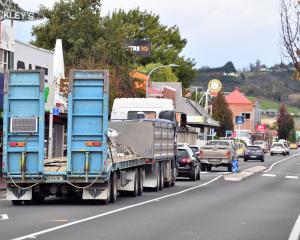A developer, who says he is frustrated by years of delays and mounting costs, has accused the Dunedin City Council of stifling city growth.
Thomas Richardson, a director of RPR Properties Ltd, voiced his concerns yesterday while arguing for a resource consent to develop a nine-lot subdivision at 41 Dalziel Rd, on Three Mile Hill.
Mr Richardson told the council's hearings committee he had spent at least $250,000 developing plans for the land, but had been knocked back repeatedly since 2004 by council planners with ''subjective ideas'' about how the site should be used.
He had originally planned a village development of at least 100 homes on the land, but scrapped the project in 2006 after two years of delays, which he blamed on council processes.
The delays related, in part, to the time it took for the council's district plan to become fully operative, which was needed before he could seek a private plan change for the development, he said.
By the time the plan was operative, the market had turned and, together with other factors, meant the development had to be cancelled, he said.
''Basically, we lost two years of opportunity because of DCC ineptitude and lack of preparedness for catering for development,'' he said.
An attempt to subdivide the land two years ago had been declined, despite not attracting a single submission against the proposal when publicly notified.
That decision was eventually overturned a year later after an appeal to the Environment Court.
The company now seeks to develop a ''simple'' rural residential development on the land that remains, featuring nine lots of about 2ha.
The council's planner has again recommended consent be declined.
Mr Richardson told the hearing that the delays and costs had led to his ''complete loss of faith'' in the process.
Council planners' ''subjective ideas'' about the land had stifled the project, he said, and those views were and remained ''detrimental to the city's growth and vigour'', he believed.
Mr Richardson's claims were not debated at yesterday's hearing, but council resource consents manager Alan Worthington said when contacted afterwards council planners were doing their best.
They were required to work within the confines of the existing district plan and resource consent requirements, but the council had rezoned ''a lot'' of land for residential use in recent years, he argued.
''The vast majority of consent applications go through without much difficulty at all. There will be some on the fringes which will be more problematic,'' he said.
''If you choose ... areas that are non-complying ... then it potentially will be challenging.''
Mr Richardson's subdivision would create nine 2ha rural residential lots on the site, where a bushy gully and stone walls would be protected by covenant.
The proposal attracted seven submissions - three opposing, two supporting and two neutral. Two neighbours were concerned in part about lost rural views. The Otago Regional Council wanted geotechnical assurances.
Council planner Howard Alchin told the committee the proposal would not comply with district plan rules, and consent should be declined, but the decision was ''so close you could make a call either way''.
RPR Properties Ltd director and consultant planner Emma Peters said the site was an isolated pocket of rural land bordered on three sides by residential and rural residential developments.
The company's application included a building site suitability report from Geolink Land Investigations Ltd, which found all but one should have no limitations on development. One site had moderately steep slopes and moderate limitations on development, requiring geotechnical work.
The subdivision's layout was designed to follow the physical features of the site, including the rock walls, but the 2ha size of each lot was not critical and the layout could change, she said.
She agreed to an offer from commissioner David Benson-Pope, the committee's chairman, to take an adjournment while a revised layout was considered over the next two weeks, after which the hearing would resume.












